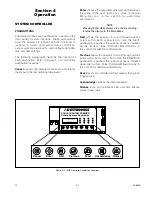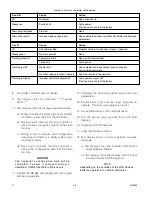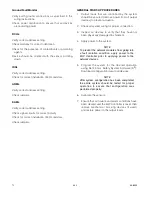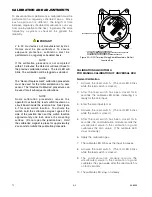
7.1
95-8533
4-15
INTELLIGENT PROTECTION MODULE
The Intelligent Protection Module (see Figure 4-9) has
18 LED status indicators, two for the device and two
for each channel, located on the front panel. Refer to
Tables 4-12 and 4-13 for a description of the LED
indicators.
POWER-UP SEQUENCE
Set the module address switch prior to applying power.
The Intelligent Protection Module power-up sequence
illuminates the LEDs for the device and all of its
channels. First the power and fault LEDs are
illuminated, indicating that the device is in a power-up
mode. Next the LEDs are illuminated in the following
sequences:
• Sequentially each channel active red LED is
illuminated, starting with channel 1 and continuing
through channel 8.
• When the red LED for channel 8 is illuminated,
sequentially each channel active red LED is turned
off, starting with channel 1 and continuing through
channel 8.
• Next, the channel fault amber LEDs are tested in the
same manner as the channel active red LEDs.
When all the LEDs have been illuminated, the
intelligent protection module displays the device’s
LON address by illuminating the channel active red
LED. LON dip switches 1 through 8 will be displayed
on channels 1 through 8. When a dip switch is set to
the ON position, the channel active red LED will be
illuminated. The address is displayed for two
seconds.
Once the address has been displayed, the device’s
fault LED will turn off.
After the power-up sequence, the device will either
display an unconfigured state or normal operation
state. In the unconfigured state, the channel fault
amber LEDs flash ON and OFF at the same rate for all
channels.
EMBEDDED LOGIC – PURPOSE
The IPM employs an “Embedded logic” feature that
when activated during module configuration can
ensure a local level of protection for the hazard during
times where communication with the EQP Controller is
lost or the EQP Controller is offline for repair or
replacement.
EMBEDDED LOGIC – CONTROL TRANSFER
SEQUENCE DESCRIPTION
A user configurable selection is provided to choose
the operational mode of the IPM. Three modes are
provided, two of which utilize the embedded logic
feature.
If enabled, the embedded logic is armed at all times
but control of the outputs depends on the selected
mode.
In the “back-up mode” control of the IPM outputs
transfers to the IPM’s embedded logic in the event of
an IPM diagnosed loss of communications between
itself and the EQP Controller.
An IPM diagnosed resumption of nor mal
communications with the Controller will cause control
of the IPM outputs to transfer back to the Controller
unless a release sequence has been initiated and is
not yet complete.
Table 4-13—Intelligent Protection Module - Channel Status Indicators
LED
Channel Status
Red
When On steady indicates the input circuit is
closed or the output circuit is active.
Amber
When Blinking indicates a low power condition is
present or channel is not properly configured.
Steady indicates a channel fault.
Table 4-12—Intelligent Protection Module - Device Status Indicators
LED
Device Status
Green
On when power is present.
Amber
When On steady indicates device is disabled or
must be replaced. Possible Watchdog Timer
problem.
Note
Blinks one time at power-up.
Figure 4-9—Intelligent Protection Module Status Indicator Location
STATUS INDICATOR LEDs
Summary of Contents for DET-TRONICS 95-8533
Page 128: ...7 1 95 8533 A 4 Figure A 1 System Drawing 007545 001 ...
Page 129: ...95 8533 A 5 7 1 Figure A 2 System Drawing 007545 001 ...
Page 131: ...95 8533 7 1 B 2 Figure B 1 Drawing 007546 001 ...
Page 132: ...95 8533 7 1 B 3 Figure B 2 Drawing 007546 001 ...
Page 134: ...95 8533 7 1 C 2 Figure C 1 Drawing 007547 001 ...
Page 141: ...95 8533 7 1 D 7 Figure D1 System Drawing 007545 001 ...
Page 143: ...APPENDIX E E 1 95 8533 7 1 ...
















































